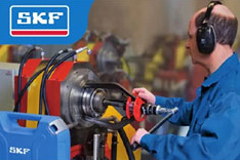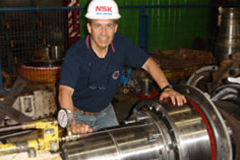




Address:Room 1602,16/F,Gaylord Building No.118 Locke Road,Wanchai HongKong
Tel:+852-30506822
E-mail:sales@hensenbearing.com
Site:www.hensenbearing.com
Bearing News
Home > News > Bearing NewsSimple identification method of lubricant
2023-05-23Core Tip: Correct use of lubricants to identify their advantages and disadvantages, the following points of experience accumulated for the following reasons: First, the lubricating oil: 1, moisture inspection; (1), the lubricant is injected into the test tube,
Proper use of lubricants to identify their pros and cons, the following points of experience accumulated for the following reference:
First, the lubricant:
1. Check the moisture; (1) Inject the lubricating oil into the test tube and observe the transparency. If it is not clear and turbid, it can be preliminarily determined that the lubricating oil contains water; (2) Inject more than half of the lubricating oil into the test tube. Heat to about 100 ~ 120 ° C, if there is noise, and there are bubbles or condensation on the wall, indicating that there is water; (3), the white powder of copper sulfate without crystal water into the lubricating oil In the test tube, if the copper sulfate turns blue and precipitates at the bottom, it indicates that the lubricating oil contains water.
2, the inspection of the particle size; (1), on a piece of clean glass placed on the horizontal, drop a drop of the lubricant to be inspected and the standard quality of the lubricant, and then tilt the glass to compare the speed of the two lubricants And the distance, the flow rate is large, the distance is far, indicating that the viscosity is low, and the viscosity is high. (2) The lubricating oil to be inspected and the standard quality lubricating oil are respectively placed in two test tubes, the oil surface is below 5 mm of the test tube mouth, the test tube mouth is sealed, and the two test tubes are inverted at the same time to observe the rising speed of the air bubbles. If the tested lubricant is faster than the standard lubricating oil, the viscosity of the oil is lower than that of the standard oil, and vice versa.
3, the identification of lubrication performance; the thumb and index finger with lubricating oil rubbing each other, if there is a sticky feeling, indicating that the oil has good lubrication properties, if the hair feels awkward, the lubrication performance has deteriorated.
4. Inspection of mechanical impurities; dilute the lubricating oil with gasoline and observe the impurities.
Second, the grease:
1. Identification of soap base; apply grease to copper sheet and then put it into hot water. If grease and water do not work, water does not change color and no emulsification occurs, indicating calcium or lithium grease, strontium Base grease; if the grease dissolves quickly into water and becomes a milky translucent milky white solution, it is a sodium-based grease; although the grease is soluble in water, it is slow and complete, indicating calcium-based grease.
2. Destructive identification of fiber network structure; put the greased copper piece into the test tube filled with water and rotate continuously. If no oil is separated, it indicates that the grease has a normal structure, if there is oil floating on it The water surface indicates that the fiber network structure of the grease has been destroyed, the adhesion has been lost, and it cannot be used any more. The main reasons are poor storage, vibration, and storage for too long.
3, the inspection of mechanical impurities; use a small amount of grease to squeeze the finger, judge the presence or absence of impurities by feeling; apply the grease on a transparent glass plate, the thickness of the coating is about 0.5mm, can be observed in the light Mechanical impurities.

